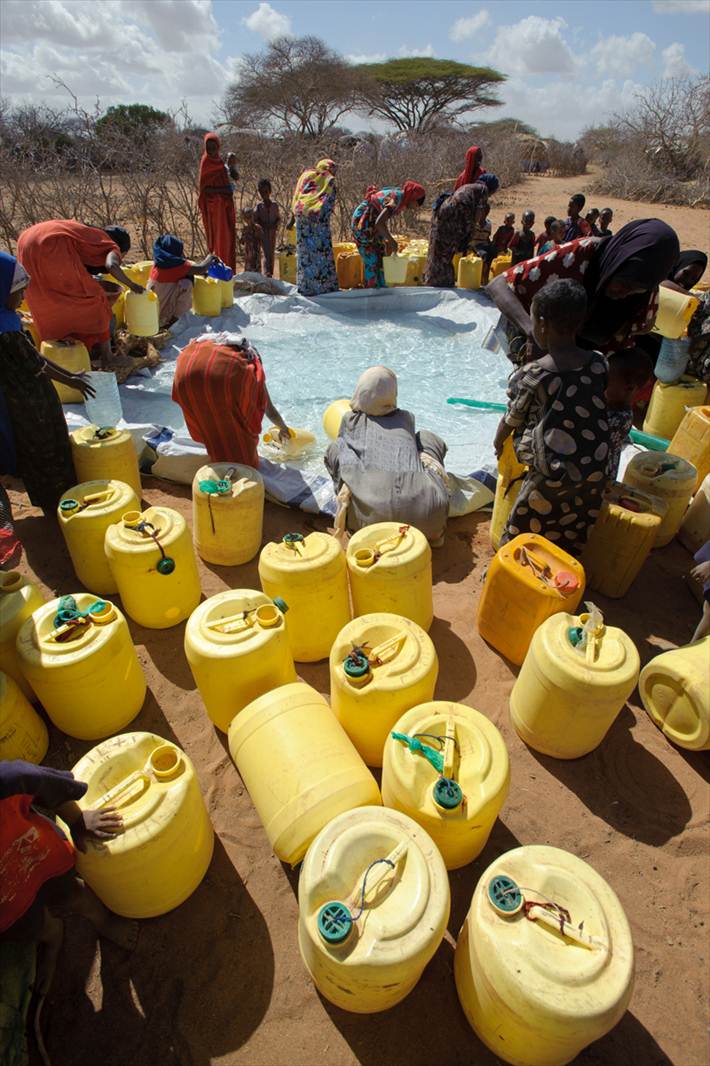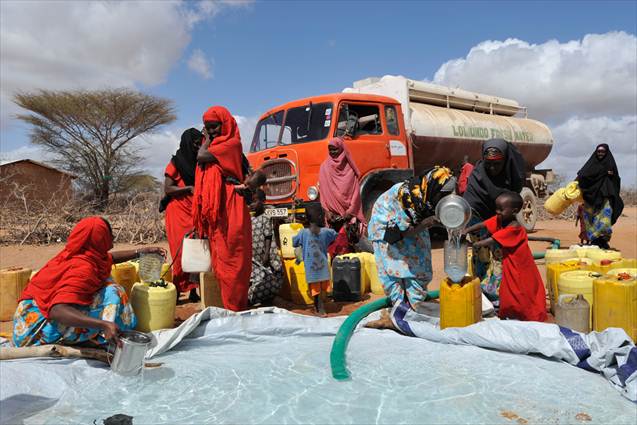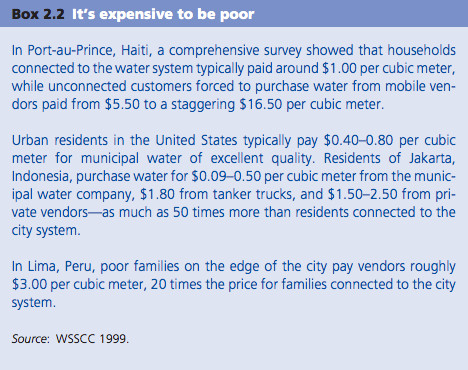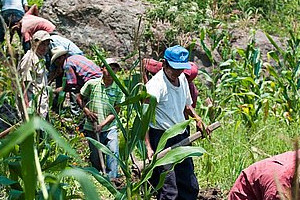Difference between revisions of "Water trucking"
(→Field experiences) |
|||
| (7 intermediate revisions by 2 users not shown) | |||
| Line 1: | Line 1: | ||
| − | [[Image:water trucking icon.png|right| | + | [[Image:water trucking icon.png|right|80px|]] |
| − | [[Image:water trucking 2.jpg|thumb|right|200px|Photo: [ | + | [[Image:water trucking 2.jpg|thumb|right|200px|Photo: [https://www.worldvision.com.au/global-issues/world-emergencies/horn-of-africa-food-crisis World Vision.]]] |
| − | [[Image:water trucking 3.jpg|thumb|right|200px|Photo: [ | + | [[Image:water trucking 3.jpg|thumb|right|200px|Photo: [https://www.worldvision.com.au/global-issues/world-emergencies/horn-of-africa-food-crisis World Vision.]]] |
| − | __NOTOC__ | + | __NOTOC__ <small-title /> |
Water trucking is an alternative water source when other, more sustainable sources cannot be found. Trucking is especially useful in emergency situations or as a response to severe drought. | Water trucking is an alternative water source when other, more sustainable sources cannot be found. Trucking is especially useful in emergency situations or as a response to severe drought. | ||
| Line 10: | Line 10: | ||
Purchase of a water tanker truck, even a second-hand one, is a major investment, but may be recouped within a year’s time, especially in the East African cities where demand for alternatives to piped water is strong. | Purchase of a water tanker truck, even a second-hand one, is a major investment, but may be recouped within a year’s time, especially in the East African cities where demand for alternatives to piped water is strong. | ||
| − | ==Field experiences== | + | ===Field experiences=== |
The following countries below show an example of some conditions where water trucking has been essential. This was during the African drought of July 2011, which affected seven million people. | The following countries below show an example of some conditions where water trucking has been essential. This was during the African drought of July 2011, which affected seven million people. | ||
| Line 27: | Line 27: | ||
In June 2011, the Danish Refugee Council (DRC) has trucked water to 9.000 internally displaced persons (IDPS). | In June 2011, the Danish Refugee Council (DRC) has trucked water to 9.000 internally displaced persons (IDPS). | ||
| − | ==Costs== | + | ===Costs=== |
[[Image:water truck costs.jpg|thumb|right|200px|Click image to zoom. Source: [http://www.worldwatercouncil.org/fileadmin/world_water_council/documents_old/Library/WWVision/Chapter2.pdf The Use of Water Today]. World Water Council.]] | [[Image:water truck costs.jpg|thumb|right|200px|Click image to zoom. Source: [http://www.worldwatercouncil.org/fileadmin/world_water_council/documents_old/Library/WWVision/Chapter2.pdf The Use of Water Today]. World Water Council.]] | ||
| Line 110: | Line 110: | ||
|} | |} | ||
| − | ==Field experiences== | + | ===Field experiences=== |
| + | The following project(s) utilize water trucking methods. | ||
| + | <br> | ||
| + | {|style="border: 2px solid #e0e0e0; width: 20%; text-align: justify; background-color: #e9f5fd;" cellpadding="2" | ||
| + | |- style="vertical-align: top" | ||
| + | |[[Image:akvorsr logo_lite.png|center|60px|link=http://akvo.org/products/rsr/]] | ||
| + | |- style="vertical-align: bottom" | ||
| + | |[[Image:project 786.jpg |thumb|center|140px|<font size="2"><center>[http://rsr.akvo.org/project/786/ RSR Project 786]<br>MWA-LAP: <br>Honduras</center></font>|link=http://rsr.akvo.org/project/786/ ]] | ||
| + | |} | ||
| − | |||
| − | |||
| − | |||
| − | |||
| − | |||
<br> | <br> | ||
| − | ==Manuals, videos | + | ===Manuals, videos and links=== |
| − | * | + | * [http://www.ircwash.org/news/eastern-africa-drought-seven-million-people-need-wash-services Eastern Africa drought: seven million people in need of WASH services]. WASH news Africa. July 2011. |
| − | * | + | * [https://www.worldvision.com.au/global-issues/world-emergencies/horn-of-africa-food-crisis Horn of Africa Food Crisis]. World Vision. May 2012. |
| − | * | + | * [http://www.irinnews.org/Report/88047/SOMALIA-Community-leaders-pool-together-to-deliver-water-to-IDPs SOMALIA: Community leaders pool together to deliver water to IDPs]. IRIN News. February 2010, Nairobi. |
| − | * | + | * [http://www.unicef.org/infobycountry/ethiopia_59887.html In Ethiopia, water trucks provide essential life-line amidst drought]. UNICEF. September 2011. |
| − | * | + | * [http://www.irinnews.org/Report/88796/MYANMAR-Coping-with-water-scarcity-in-the-Ayeyarwady-Delta MYANMAR: Coping with water scarcity in the Ayeyarwady Delta] IRIN. April 2010. "People in our village are always busy getting water. They are either waiting for water trucking or looking for places where we can fetch water. We can't do any other work in the dry season." |
| − | * Pike, Jill. [http://dspace.mit.edu | + | * Pike, Jill. [http://dspace.mit.edu/handle/1721.1/33043 Water by Truck in Mexico City]. MASSACHUSETTS INSTITUTE OF TECHNOLOGY, June 2005. |
| − | ==Acknowledgements== | + | ===Acknowledgements=== |
| − | * [ | + | * [https://washafrica.wordpress.com/ WASH news Africa]. |
* Collignon, Bernard and Vézina, Marc. [http://www.wsp.org/sites/wsp.org/files/publications/af_providers.pdf Independent Water and Sanitation Providers in African Cities: Full Report of a Ten-Country Study.] © International Bank for Reconstruction and Development/The World Bank. Hydroconseil. IRC. April 2000. | * Collignon, Bernard and Vézina, Marc. [http://www.wsp.org/sites/wsp.org/files/publications/af_providers.pdf Independent Water and Sanitation Providers in African Cities: Full Report of a Ten-Country Study.] © International Bank for Reconstruction and Development/The World Bank. Hydroconseil. IRC. April 2000. | ||
Latest revision as of 01:19, 6 May 2020


Water trucking is an alternative water source when other, more sustainable sources cannot be found. Trucking is especially useful in emergency situations or as a response to severe drought.
Africa
Water truckers supply mostly high-volume water consumers with cisterns (private villas, government and business office buildings). The market for water trucking services is most developed in cities where the concessionaire’s level of service is poor—long cutoff periods and many unserved areas, as in Nairobi, Nouakchott, Dar es Salaam, and Kampala—and less so in cities where the primary water mains reach most of the settled area, as in Dakar and Abidjan.
Purchase of a water tanker truck, even a second-hand one, is a major investment, but may be recouped within a year’s time, especially in the East African cities where demand for alternatives to piped water is strong.
Field experiences
The following countries below show an example of some conditions where water trucking has been essential. This was during the African drought of July 2011, which affected seven million people.
Djibouti
Water shortages in Djibouti City are expected to persist as the peak demand for water approaches with the lean season, increasing the risk of disease. Water access of 60,000 rural people has been supported through water trucking and repair of shallow wells and boreholes.
Ethiopia
The WASH Task Force in Ethiopia has called for additional funding between June and October 2011 to support priority water trucking and borehole maintenance and rehabilitation. The cost of providing water is rising due to the physical availability of water trucks, high local demand, restrictions on trucks from Somalia, high fuel prices, and long distances between water sources and delivery sites. At the same time, the rains have elevated the threat of acute watery diarrhoea (AWD) in areas previously affected by outbreaks.
Kenya
Heavy rains in Turkana and some parts of southern Garissa have reduced the water trucking needs by up to 50 percent while pressure on boreholes has declined in several areas. The Water Sector has prioritized water trucking as a key intervention in the short term but says obtaining funds is difficult. Since the beginning of 2011, more than 322,000 people have been reached through emergency measures, such as water trucking; 51 water points have been rehabilitated and 5 newly constructed; and appropriate sanitation has been provided to 308,562 people.
Somalia
WASH partners are distributing hygiene packages which include soap, buckets for storing treated water and jerry cans to benefit 48,000 families (approximately 290,000 people) through 335 nutrition centres in south central Somalia. Hygiene promotion materials are being distributed to help health workers visiting the nutrition centres.
In June 2011, the Danish Refugee Council (DRC) has trucked water to 9.000 internally displaced persons (IDPS).
Costs

Examples of investments made by independent water and sanitation providers in African cities.
Source: © International Bank for Reconstruction and Development/The World Bank.
| Usual source of finance | Cities | Unit cost (US$) | Asset life (years) | Cost/annual earnings ratio | |
|---|---|---|---|---|---|
| Water truck | Formal or informal loan and earnings from other activities |
Nouakchott | 15,000 | 10 | 48% |
| Nairobi | 13,000 | 5 | 19% | ||
| Kampala | 7,500 | 10 | 13% |
Annual operating accounts for three water truckers in Nouakchott, Nairobi, and Kampala.
Source: © International Bank for Reconstruction and Development/The World Bank.
| Nouakchott | Nairobi | Kampala | |
|---|---|---|---|
| Initial investment (US) | $15,000 | $13,000 | $ 7,500 |
| Number of daily clients | 2 | n.a. | n.a. |
| Volume of water sold (cubic meters/day) | 16.0 m3 | 21.3 m3 | 54.8 m3 |
| Unit sales price (US$/m3) Unit cost (US$/m3) |
$3.80 $1.00 |
$8.30 $2.10 |
$4.30 $1.10 |
| Annual gross revenue (US$) | $22,192 | $64,889 | $86,800 |
| Annual expenses (US$) Purchase of water Taxes and insurance Payroll Fuel and maintenance Depreciation allowance |
$13,435 $5,840 $485 $2,100 $3,510 $1,500 |
$20,240 – $804 $2,796 $14,040 $2,600 |
$35,942 $21,600 $800 $2,592 $ 10,200 $750 |
| Annual profit | $8,757 | $44,649 | $50,858 |
| Daily profit | $23.99 | $122.33 | $139.34 |
Field experiences
The following project(s) utilize water trucking methods.
 MWA-LAP: Honduras |
Manuals, videos and links
- Eastern Africa drought: seven million people in need of WASH services. WASH news Africa. July 2011.
- Horn of Africa Food Crisis. World Vision. May 2012.
- SOMALIA: Community leaders pool together to deliver water to IDPs. IRIN News. February 2010, Nairobi.
- In Ethiopia, water trucks provide essential life-line amidst drought. UNICEF. September 2011.
- MYANMAR: Coping with water scarcity in the Ayeyarwady Delta IRIN. April 2010. "People in our village are always busy getting water. They are either waiting for water trucking or looking for places where we can fetch water. We can't do any other work in the dry season."
- Pike, Jill. Water by Truck in Mexico City. MASSACHUSETTS INSTITUTE OF TECHNOLOGY, June 2005.
Acknowledgements
- WASH news Africa.
- Collignon, Bernard and Vézina, Marc. Independent Water and Sanitation Providers in African Cities: Full Report of a Ten-Country Study. © International Bank for Reconstruction and Development/The World Bank. Hydroconseil. IRC. April 2000.
